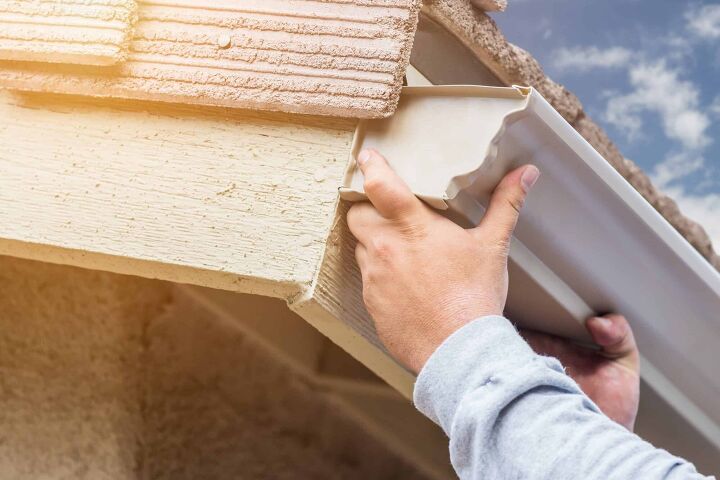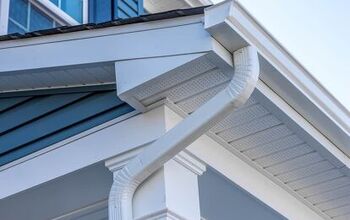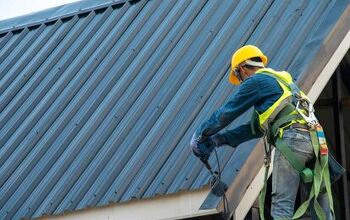How To Install Gutters Without Fascia (Step-by-Step Guide)

Gutters are an important part of your home. They direct rain and melted snow away from your home, keeping it safe from rot, leaks, and erosion. Your home needs gutters even if you don’t have fascia.
You can install gutters without fascia by using roof straps. Just fit them into the gutter’s hanger and then attach that directly to your roof. The straps will act as a sling that keeps the gutters fitted securely to your roof.
If you’re planning on installing gutters to your roof, it’s important to know what you’re doing before starting. This guide should help you with that. Continue reading to learn everything you need to know about installing gutters without fascia.
Do You Need Roofing, Siding, or Gutter Installers?
Get free, zero-commitment quotes from pro contractors near you.

Do Gutters Need Fascia?
You don’t need fascia to install gutters to your home. However, fascia boards perform several essential functions that you’ll want to replicate somehow if you don’t have them.
The most important task fascia boards accomplish is providing a solid foundation for your gutters. They can also help to keep pests out of your home. If you’re moving forward with a gutter installation that doesn’t include fascia boards, keep the jobs it accomplishes in mind. You may want to start thinking about how to replicate those functions in another way.
What Tools Do You Need to Install Gutters Without Fascia?
The first step in installing gutters without fascia is gathering the tools you need to get the job done. For this job, you’ll need:
- Pop rivet gun
- Duckbill tin snips
- Ladder
- Measuring tape
- Cordless drill
- Hex head driver
- Offset tin snips
- Crimper
In addition to these tools, you should also gather all of the materials you need before starting. These include:
- Gutter
- Gutter flashing
- Gutter sealant
- Gutter hanging strap
- Elbows
- Downspouts
- 1/8-inch medium length rivets
- 1/4-inch hex head screws
- 1 1/4-inch self-tapping head screws
- Roof straps
How to Install Gutters Without Fascia
- Measure your house and note your planned downspout areas and any challenging sections that may need special attention.
- From the ground, cut the gutter to your desired length. Cut the front and back sides with tin snips. Then, bend the gutter as needed and cut the bottom.
- Notch the gutter with your tin snips to make it easier to join the section with a corner piece down the line.
- Snap the sections together by laying gutter sealing about 1-1/2-inch from the edge. Find the notched section of the gutter, hook the front lip of the corner over it, and then snap it over the gutter.
- Rivet the sections by first drilling a 1/8-inch hole (to match the rivet size) at the front of the gutter. Install the first river with your rivet gun, then repeat this process until you’ve made every rivet you need.
- Caulk the seams with gutter sealant inside the gutter and over each rivet.
- Preassameble it all before taking it up the ladder with you.
- Mark the downspout outlet
- Cut the outlet hole with your offset tin snips, about 1/16-inch from the outside line.
- Rivet the outlet in the hole with pre-drilled 1/8-inch holes.
- Measure the slope you need
- Mark the gutter slope
- Attach the gutters to your home with roof straps
- Add gutter flashing to present water from getting behind your gutters. Ideally, this should be installed underneath your shingles and any ice or water barrier you may have in place.
- Attach elbows to your downspout
Can You Install Gutters Yourself?
Installing gutters is more complex work than your average DIY project. However, that doesn’t mean you can’t do it. You can still new gutters yourself as long as you take enough time to be careful and precise in everything you do.
You should also use safety precautions like working in pairs and exercising caution while placing your ladder. If you’re not very handy or feel incapable of taking the steps outlined above, you probably shouldn’t install gutters yourself. Instead, consider hiring a contractor who can complete the work for you in the right way.
What Type of Gutters Should I Use?
Homeowners have several different types of gutters to choose from, including:
- K-Style
- Half-round
- Aluminum
- Copper
- Seamless Aluminium
- Steel
- Vinyl
- Zinc
Each of these options has a different set of pros and cons that may appeal to you based on your goals. For example, aluminum is the most widely-used type of gutters. It’s popular because it’s lightweight and easy enough for DIYers to install on their own. It’s also fairly cheap and rust-proof.
Copper is another solid choice if you’re looking for beautiful gutters that won’t rust. However, it will cost more than some of your other options.
Ultimately, you should choose your gutters based on your specific needs. Your decision should be impacted by factors like the kind of home you have, the weather in your area, and your budget.
What Happens If You Don’t Have Gutters on Your House?
Gutters can be a pain to install and upkeep. Because of that, you may be wondering whether you actually need to have gutters on your home. The answer to that question is a resounding yes.
Gutters are an essential part of your home for a few key reasons. First, they prevent erosion by directing rainwater away from your foundation. If left unchecked, erosion can cause water to flow into your home instead of away from it.
Gutters also prevent basement flooding. When you don’t install gutters, the soil around your home becomes saturated with water. This puts pressure on your basement that can crack its foundation, ultimately causing water to flow into it.
Your gutters will also protect your siding. Rainwater can carry dirt, leaves, and shingle particles as it flows off of your home. This can stain your siding, creating a number of unnecessary repair and maintenance tasks.
What Can I Use Instead of Gutters?
While gutters serve important functions, they can also be costly to install and difficult to maintain. You may be able to replace some of their functionality with a gutter alternative that’s cheaper and easier to install.
There are several different options you can choose from, including:
- Rain chains
- Rain dispersal systems
- Grading
- Drip edges
- Ground gutters
- Drip paths
- Built-in gutters
Each of these is a viable way to keep your home safe from erosion and water damage. However, every house has different needs.
You should check with a professional before making the decision to forego gutters. Doing so will ensure you don’t make a mistake that could end up costing you more than installing gutters.
Do You Need Roofing, Siding, or Gutter Installers?
Get free, zero-commitment quotes from pro contractors near you.

Related Questions
Are gutters really necessary?
Your home absolutely needs either gutters or a carefully-selected gutter replacement. If you neglect to install one of these, your house will be at a serious risk of sustaining significant water damage.
Do you install gutters under the drip edge?
Your drip edge should be installed under the first course of shingles. This ensures that water will run naturally down your gutter.
How far should gutters be from my house?
For the best results, experts recommend extending your gutters at least four feet from your home. You may want to extend your gutters even further from your home if you expect them to deal with a lot of rain. This ensures you aren’t unwittingly sending the water your gutters collect exactly where you didn’t want it to go.
Related Guides

We are a team of passionate homeowners, home improvement pros, and DIY enthusiasts who enjoy sharing home improvement, housekeeping, decorating, and more with other homeowners! Whether you're looking for a step-by-step guide on fixing an appliance or the cost of installing a fence, we've here to help.
More by Upgraded Home Team



























